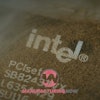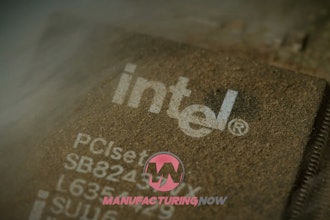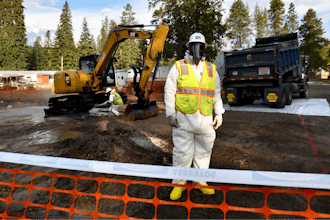News about food safety seems to be everywhere lately. Every day, there’s a story about a salmonella outbreak or a company having to recall products due to possible contamination. In 2015, there were 420 recalls, market withdrawals and safety alerts for food products according to the FDA1. Why is this the case?
Chances are, if you visit a food manufacturing plant, you’ll see two different worlds. The plant floor will be almost fully automatic and have state-of-the-art machinery with minimal manual work involved. Yet, in the offices upstairs, people will be using pen and paper checklists, forms and log books to manually manage food quality, safety and regulatory operations.
Food manufacturers are able to keep track of how much food is produced with incredible detail, but they’re unable to track their performance in meeting regulatory requirements. Large food manufacturers may have systems in place to track compliance activities, but mid-sized and small manufacturers often lack the resources needed to keep up with today’s ever-growing list of regulations. Regardless of the company’s size, being a food manufacturer is vastly different today than it used to be.
Modern Food Safety Isn’t So Modern
For one thing, there is a lot more paper to manage in today’s world. Between time and temperature controls, audit log requirements, supplier rules and a whole host of industry certifications and brand standards, food manufacturers have a lot of safety processes to administer. Even with advancements in technology, food safety operations are often based on ad hoc processes, heavily manual, and error-prone.
Up until a few years ago, food manufacturers could handle the volume of paperwork themselves. Today, they’re swamped. Visit a manufacturer and you’ll see the same thing everywhere: stacks of documents that have to be typed up and sent to third-party auditors, supply chain partners, or food agencies. A common refrain among quality assurance managers is: “We can barely keep track of it all and our paperwork keeps increasing.”
Surrounded by stacks of paper in their office, plant managers explain that much of it is because there are more rules and regulations these days when it comes to food safety. In the past, compliance was a small part of a manufacturer’s workload. Local health officials rarely came by, and when they did, they’d conduct an informal inspection of the facility — hardly taking any notes.
Today, all of that has changed. Food businesses have to comply with a growing number of local, state and federal regulations that govern food safety — and the focus of recent laws such as the Food Safety Modernization Act is toward prevention of foodborne illness, placing much more emphasis on internal audits and record-keeping. On top of these laws, manufacturers now face increased quality and safety process requirements from distributors and retailers, in order to be able to sell their products.
Blue Bell Ice Cream, for example, had a highly publicized listeria outbreak in 2015, which led to their products being taken off the shelves. Blue Bell spent months upgrading its food safety operations and dealing with angry customers and media commentators. Blue Bell was eventually able to get its products back on store shelves, but the damage to the brand had been done. Blue Bell lost serious revenue, its operating costs increased, and most importantly, it damaged its reputation with customers.
A Day in the Life of a Quality Assurance (QA) Manager
Complying with food safety laws often falls on the company’s QA manager who supervises quality, safety and compliance operations. The QA manager is also responsible for ensuring all front-line workers are up to speed on food safety rules and best practices and walks through the plant several times a day with clipboard in hand, reviewing a list of safety and quality measures.
The QA manager will then manually key this data into a spreadsheet, create reports and file the results with industry partners and government regulators. These seemingly routine and time-consuming compliance tasks matter: failing to comply with the appropriate laws can lead to costly penalties, permitting delays, loss of business from industry partners (such as retailers with strict requirements), and even legal action.
The legal requirements are complex, overlapping, and change every couple of years. The laws are designed, of course, to ensure that food preparation and delivery is safe — protecting consumers. But an expanding body of regulations and fear of litigation have increased the time, cost and stress of compliance for most food businesses.
The Future of Food Safety
So how can manufacturers improve their food safety and compliance operations? By using food safety technology — particularly mobile software tools — to improve their processes. Since food safety operations are often manual, they tend to be hard to standardize and difficult to track — especially at larger companies where employees are working in multiple shifts across dozens of locations.
Mobile food safety software offers several major benefits:
- No More Pen and Paper — Replacing paper-and-pencil clipboards with digital tools saves time and money. Digital audits and task-lists can be logged and tracked, ensuring that staff are performing tasks in real-time. Digital entries are more accountable — managers can confirm when and where tasks were done (including requiring photos to be taken). And digital clipboards can also be loaded with reference materials like images and training videos, helping staff learn best practices and prepare for inspections by government agencies.
- Quality and Safety Checklists — Instead of letting employees complete tasks ad hoc and make notes on clipboards and log books, companies can use quality and safety checklists to ensure key tasks are standardized across the organization. For example, data can be collected showing that a company is always forgetting to label produce with an expiration date. Digital food safety and quality checklists loaded on smart phones or tablets makes it easier to ensure that all employees are following compliance standards and best practices.
- Automated Reports — Instead of sifting through binders filled with audit logs, food safety software captures and stores data in a structured format — making it easy to search and analyze. Why waste hours at the end of every week or month sifting through binders full of paper, when software enables you to generate insights with the click of a button?
- Real-Time, Centralized Management — Food manufacturers often have multiple employees responsible for conducting quality, safety and compliance tasks at several sites. For companies with employees working at multiple facilities, mobile software can be used by staff at each location to help managers track performance by location, provide critical alerts in real-time and give employees immediate feedback to continuously improve food safety operations.
Here’s an example of a QA manager running a food safety audit in a plant using mobile software. During a random spot check, the manager shows up on the line with a tablet in hand. As he/she walks around, the manager pulls up a food safety application and answers a series of pre-set multiple choices questions that cover key criteria, dictates comments into the device using the built-in voice recognition and takes high-resolution color photos of several problematic issues. If a QA manager is unsure about food safety requirements, they can quickly pull up a reference document (or even the official code citation) from state, FDA, USDA, or other agencies.
After running a digital audit with food safety software, the QA manager can immediately print or e-mail a report that shows all of the items “out” of compliance — creating actionable intelligence for the team. The QA manager can immediately share this report with a particular employee, or wait to discuss it with the line staff during a regular team meeting — helping train all workers on best practices in food safety.
The data collected by the QA manager through the tablet is immediately stored in the cloud. From there, it can be easily accessed by a colleague (such as a supervisor back at corporate) at any time. Over time, the data from each of these spot checks gets stored in a central database that a manager can analyze, looking for trends in performance, issues that keep getting identified, or locations that may need extra training and attention. Mobile software makes it easier to generate insights that can drive major improvements in an organization’s safety and quality performance.
By using software to help manage line checks, food safety audits and log books, manufacturers can save time and money on compliance, train staff on best practices and, most importantly, reduce foodborne illnesses and costly product recalls.
Today, food safety technology — especially mobile software — should be a critical part of any food manufacturer’s operations. Mobile audit and task-management tools allow companies to streamline and standardize food safety and regulatory operations across large teams and multiple locations, helping save valuable time and money.
Modern software tools can help food manufacturers of all sizes effectively manage time-consuming tasks around food safety and compliance — from digitizing audit logs for analysis to creating automated filings for supply chain partners. So as a food manufacturer, consider using modern software tools to help you do what you do best: make safe, great-tasting food that your customers love.
About the author
Manik Suri is the CEO and co-founder of MeWe, Inc, a technology company that builds mobile software to help organizations manage quality, compliance, and brand standards. Manik holds an A.B. from Harvard College, a J.D. from Harvard Law, and a Master’s degree from Cambridge University. He can be reached at [email protected].























